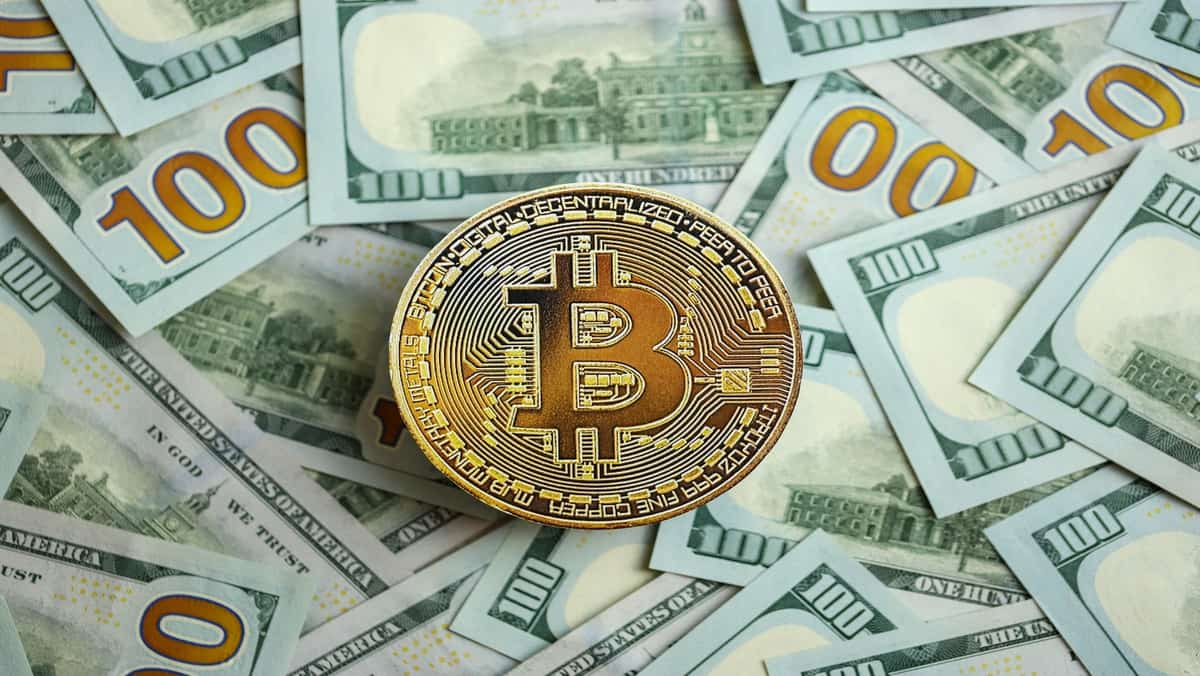- Despite evidence of a strong economy, the Federal Reserve will likely stick with plans to cut rates this year, because short-term interest rates are well above policymakers’ estimates of “neutral”.
- In Grayscale Research’s view, this macro backdrop—as well as favorable supply/demand technicals due to the halving—could be consistent with further increases in Bitcoin’s price this year.
- There is increasing conversation in crypto markets about Ethereum, which faces competition from other smart contract platform blockchains, as well as a pending decision about spot ETF approval in the US market.
Bitcoin’s price has consolidated in a relatively narrow range since reaching an all-time high on March 13 (Exhibit 1). Although certain macro risks have increased, Grayscale Research sees a glass half full, continuing to believe further increases in price are possible this year.
Exhibit 1: Bitcoin’s price consolidating after reaching all-time high

Since Bitcoin’s high on March 13, changes in valuations for traditional assets look consistent with a more positive outlook for global economic growth, as well as higher inflation risks. On a risk-adjusted basis (i.e. accounting for each asset’s volatility), gains have been led by physical commodities, equity markets in Western Europe and Emerging Markets, as well as assets tied to US consumer price inflation (Exhibit 2). Perhaps reflecting rising medium-term inflation risks, long-maturity Treasury bonds significantly underperformed. Certain technology-oriented market segments (e.g. the Nasdaq 100, BioTech stocks, and recent IPOs) were flat or declined. After outperforming most other assets since the start of the year, Bitcoin and especially Ether underperformed on both an absolute and risk-adjusted basis.
Exhibit 2: Commodities and inflation measures leading markets since mid-March

Lower odds of Fed rate cuts have likely contributed to Bitcoin’s recent pullback, in our view. Since mid-March 2024, US economic indicators have continued to surprise on the upside. For example, the March Employment Report, published Friday April 5, 2024, showed monthly job gains of about 300,000, rising labor force participation, and a higher average workweek.[1] Evidence of a strong economy and moderately higher inflation readings have resulted in reduced expectations for Fed rate cuts. At one point in January 2024, markets had priced as many as seven 25bp rate cuts this year. As of Monday, April 8, 2024, this had been trimmed to just under three 25bp rate cuts (Exhibit 3). All else equal, rising short-term interest rates will tend to support the value of the US Dollar and weigh on the value of Bitcoin (for background see our earlier report Crypto and the End of Fed Tightening).
Exhibit 3: Fewer Fed rate cuts priced into markets

Nonetheless, the central case outlook continues to be for lower short-term interest rates—both in the US and every other major market except Japan. As recently as its March 19-20 meeting, a majority of Federal Reserve officials shared expectations to reduce rates three times this calendar year, despite forecasting stronger GDP growth and higher core inflation.[2]
Moreover, the Fed’s framework is likely to continue to steer policy toward lower interest rates, even if near-term data continue to show strong nominal growth. According to their latest projections, Fed officials seem to believe that short-term interest rates will be 2.5-3.0% in the longer-run, which can be interpreted as their estimate of the “neutral” policy rate.[3] Because current policy interest rates at 5.25-5.50% are well above their estimate of “neutral”, the central bank believes that monetary policy has become unnecessarily tight now that inflation has moderated. Although there is debate about the level of neutral interest rates in policy circles, the Fed’s line of thinking is likely to keep rate cuts on the table. In our view, Fed rate cuts in the context of strong economic growth and above-target inflation should be considered positive for Bitcoin.
In addition, Bitcoin’s supply/demand technicals are likely to tighten as a result of the upcoming halving event (the Bitcoin halving will occur in block number 840,000; at the current rate of block production this will likely occur in the early morning hours of April 20, US Eastern Time). At the halving, the rate of new Bitcoin issuance will fall by half, from about 900 coins per day to about 450 coins per day, or by $31.5 million at an average Bitcoin price of $70k. Although net inflows into the US-listed spot Bitcoin ETFs have slowed since February and March 2024, they have still averaged about $80mn per calendar day over the last two weeks.[4] Taken together, a strong economy, likely central bank rate cuts, and favorable supply/demand technicals should support Bitcoin’s price, in our view. After a period of consolidation in Bitcoin’s price, measures of active trader position (e.g. funding rates) now appear more balanced[5], which also may indicate a favorable market outlook over the short-term.
There is increasing conversation in crypto markets over the outlook for Ethereum, the second largest blockchain network by market capitalization. Since the mid-March high for crypto markets, the Ethereum network’s Ether token (ETH) has underperformed Bitcoin (BTC) by about six percentage points (Exhibit 4).
Exhibit 4: Ether underperforming Bitcoin

Unlike Bitcoin, which dominates the Currencies Crypto Sector, ETH faces meaningful competition within the Smart Contract Platforms Crypto Sector. And although the ETH ecosystem has seen a meaningful increase in active users this year, the network’s modular architecture has meant that this has not translated into a commensurate increase in fee revenue, because new activity is taking place primarily on Layer 2 chains and sidechains (Exhibit 5). ETH may also have been held back by lower perceived odds of spot ETF approval. According to the decentralized prediction platform Polymarket, consensus expectations for spot ETH ETF approval have fallen about 20% from around 80% in January. A decision by the SEC on approval or denial is expected by late May 2024.
Exhibit 5: Ethereum ecosystem activity not translating into mainnet fee revenue

Bigger picture, Grayscale Research remains optimistic about the outlook for Ethereum. Token value accrual ultimately derives from network adoption for sustainable (i.e. non-speculative) use cases. Compared to other smart contract platform blockchains, Ethereum continues to boast the most users, developers, and applications. Ethereum should therefore be well-placed to compete for users over time. That being said, there continue to be near-term risks to ETH valuation related to spot Ethereum ETF approval, and competition with the Smart Contract Platforms Crypto Sectors is likely to remain intense. For Ethereum to retain its leading position, its ecosystem will need to remain the leading destination for the deployment and adoption of decentralized applications over time.
[1] Source: Bureau of Labor Statistics.
[2] Measures of core inflation typically exclude volatile food and energy prices.
[3] The “neutral” rate of interest is the rate at which policy is neither supporting or restraining economic growth.
[4] Source: Grayscale calculation based on Bloomberg data as of April 8, 2024.
[5] Source: CoinGlass, as of April 8, 2024.
















